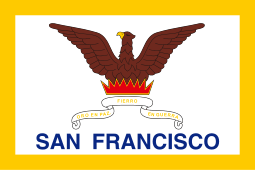C. K. Garrison
| Cornelius Kingsland Garrison | |
|---|---|
 | |
| 5th Mayor of San Francisco | |
|
In office October 3, 1853 – October 1, 1854 | |
| Preceded by | Charles James Brenham |
| Succeeded by | Stephen Palfrey Webb |
| Personal details | |
| Born |
March 1, 1809 Fort Montgomery, New York |
| Died |
May 1, 1885 (aged 76) New York City |
Cornelius Kingsland Garrison (March 1, 1809 – May 1, 1885) was a shipbuilder, capitalist, and the fifth Mayor of San Francisco (1853–1854). He was born in Fort Montgomery, near West Point, New York. During his childhood, he studied architecture and civil engineering while working on his father's schooner.
After moving to Buffalo in 1830, he worked as a builder, then moving to Canada in 1834 where he built bridges and other marine building projects. He moved to St. Louis in 1839, where he made a fortune from owning, building, and commanding boats. He later moved to Panama, where he worked as an agent for the Nicaraguan steamship company and also established the banking firm of Garrison, Fritz, and Ralston.
The business partnership of Morgan & Garrison, which Garrison formed with Charles Morgan, was reportedly once the recipient of a brief and now very famous letter: "Gentlemen: You have undertaken to cheat me. I won't sue you, for the law is too slow. I'll ruin you. Yours truly, Cornelius Vanderbilt."[1][2] This letter appears to be apocryphal, however, its only primary source being Vanderbilt's New York Times obituary, published almost 25 years after the letter was supposedly written.[3]
After he moved to San Francisco, he was elected mayor of that city in 1853. While he was mayor, he started the movement that led to the founding of the Pacific Mail Steamship Company. After his term as mayor, he returned to New York, where he became a speculator.
During the Civil War, he allowed the U.S. government to use most of his ships. After the war, he bought a large interest in what later became the Missouri Pacific Railroad, which he became president of after it was reorganized. He would also lose a lawsuit which resulted from this reorganization.
He died on May 1, 1885 in New York City of a heart attack. He in interred at Green-Wood Cemetery in Brooklyn, New York.
References
External links
- Findagrave.com
- List of mayors of San Francisco from the Political Graveyard
- San Francisco's Alcades and Mayors
- Green-Wood Cemetery Burial Search
